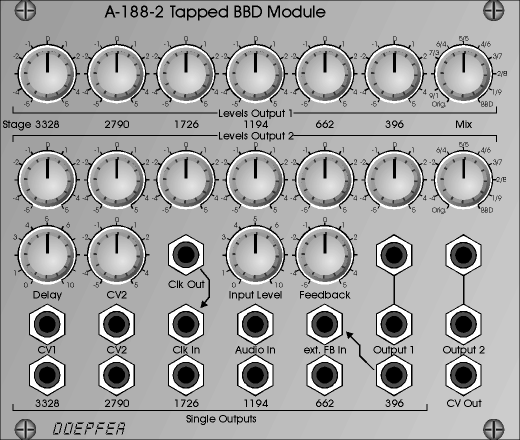



( Please contact first before visiting)






Analogue Modular System A-100















Multi-Tapped Bucket Brigade Delay


The A-188.2 uses a tapped BBD that has six outputs, tapped at stages 396, 662, 1194, 1726, 2790 and 3328. The module has available two separate mixing sub-units. For both mixes the levels and polarities of each BBD output can be adjusted to obtain two different mixes of the BBD outputs. A new type of control with centre detent and centre terminal is used for the BBD mixing controls to have a better feel for the neutral position. Each mixer has a wet/dry control at its output that allows choosing between the pure input signal (original), the BBD mix or anything in between. The two outputs can be treated as stereo outputs but it is also possible to use one of the outputs for other applications.
The A-188.2 has a feedback section available but as we now have 6 different BBD outputs available, 6 different feedback types are possible. But by patching the feedback socket to any of the single output sockets another BBD tap can be used for the feedback to obtain different sounds. Even external feedback processing is possible (e.g. with a VCA for voltage controlled feedback). The feedback control has polarizer function, i.e. the neutral position is at the centre. Left from the center the feedback signal is subtracted from the input signal, right from the centre it's added (negative/positive feedback).
A special feedback can be obtained if one of the mix outputs is used for the feedback function. In this case for each tap the positive or negative feedback share can be adjusted. This leads to multiple peaks and/or notches in the frequency response of the module. For each tap of the BBD a separate output socket is available. These sockets can be used for changing the feedback loop - as mentioned above -, for voltage controlled mixing of the taps - e.g. with the voltage controlled mixer A-135 or other applications that require access to each single tap.


























